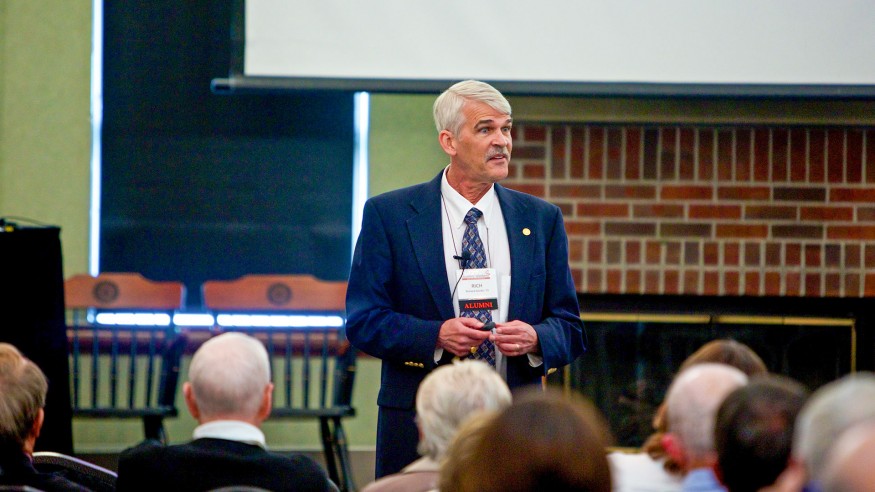
OWU Graduate, Delaware Native Rich Gordin Shares Message of ‘Realistic Optimism’
Dr. Rich Gordin ’73 presented thoughts about realistic optimism during his Alumni College Session. (Photo by Mark Schmitter ’12)
“I’ve been in Utah for 35 years, but (Delaware) is still my home,” said Rich Gordin ’73, toward the end of his recent Alumni Weekend presentation on “realistic optimism.”
For Gordin, Ph.D., this spirit of realistic optimism was instilled in him by many people at Ohio Wesleyan, and he now passes it on as a Utah State University professor and sports psychologist for U.S. Olympians and other professional athletes.
His May 16 OWU “Alumni College” presentation focused on different perspectives by various figures, many of them not connected to athletics, and how they have influenced his own methods of instilling realistic optimism.
The term was coined by Admiral James Stockdale, now deceased, as a result of Stockdale’s experience as a prisoner of war in Vietnam. He was held for more than seven years in the same POW camp as now-U.S. Sen. John McCain. Stockdale was released in 1973. Coincidentally, Stockdale’s son, Jim, graduated from Ohio Wesleyan in 1972 when Gordin was a junior.
Gordin defines realistic optimism as maintaining an unfailing faith in “the endgame.”
The spirit focuses on eventual rather than immediate or specifically timed success, regardless of the difficulties at hand. It focuses on confronting the most brutal facts instead of avoiding them.
Gordin also discussed confronting fear rather than avoiding it, both on the field and off. He questioned advertisements, used for everything from clothing to energy drinks, branded as “No Fear.”
Every athlete he’s worked with experiences fear, Gordin said. “They don’t avoid it; they learn to deal with it.”
Gordin also questioned the common statement that players should give “110 percent.” If someone only has 85 percent on one day, the person should give 100 percent of that 85, he said.
Even if athletes do give 100 percent, they can still lose – and in working with Olympic athletes, helping with failure is an important role.
Olympians train ten to twelve years for a very small moment in time, Gordin said toward the opening of his presentation.
In one of the areas Gordin works with, Nordic combined skiing, the initial jump can determine how the entire event goes.
“You’ve trained for 12 years, and you have a bad jump, you’re done,” Gordin said.
He recounted a saying one of his athletes passed on about the Olympics and professional golf: PGA athletes have four finals every year; Olympians have one final every four years.
Regardless of the sport, Gordin said, athletes can’t let self-doubt get in the way or build the case for why they can’t win. Though Gordin works mainly with athletes of college age or above, the same teachings of sports psychology should be shared with younger athletes to develop mental skills as well as physical ones, he said.
In addition to Gordin, Ohio Wesleyan’s 2014 Alumni College also featured:
“From Beeghly to the World: The Global Walt Whitman,” presented by 1969 OWU alumnus Ed Folsom, Ph.D., editor of the Walt Whitman Quarterly Review and professor of American literature at the University of Iowa College of Liberal Arts and Sciences. “How Economics Plays a Role in Conserving, Reserving, and Restoring Nature,” by 2004 alumnus Sahan Dissanayake, Ph.D., assistant professor of economics at Maine’s Colby College, specializing in environmental and resource economics. “The Year the Future Began,” by 1974 alumnus W. Joseph Campbell, Ph.D., tenured professor at American University’s School of Communications in Washington, D.C. His presentation is tied to his forthcoming book, 1995: The Year the Future Began. “Portrait of the Poet as a Young Bishop,” by 1999 alumna Maggie Smith-Beehler, owner of Versed Creative Services and author of five collections of poems and the upcoming The Well Speaks of Its Own Poison.